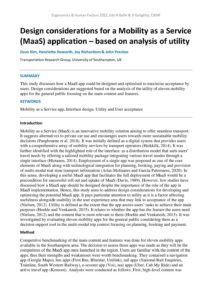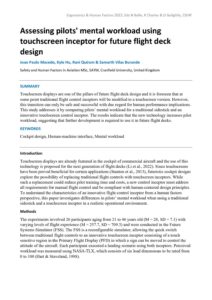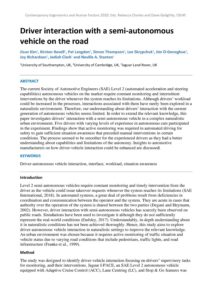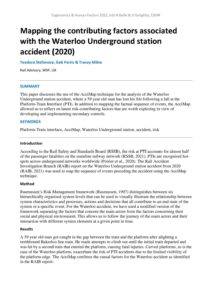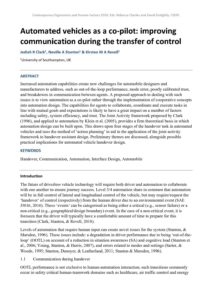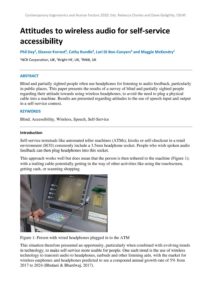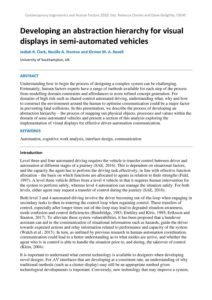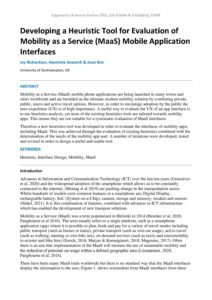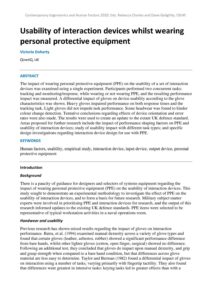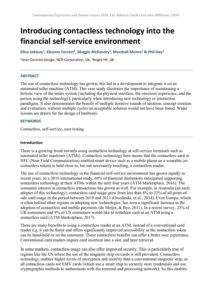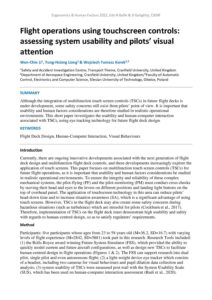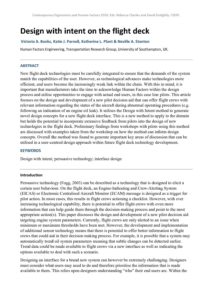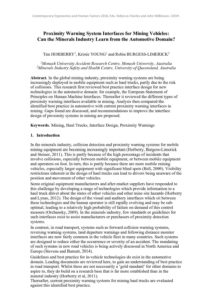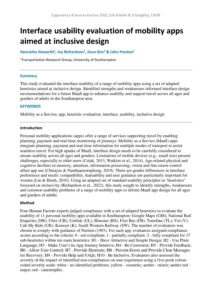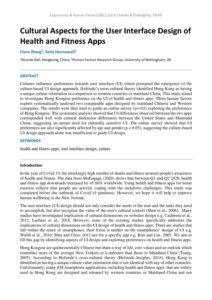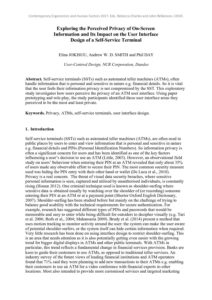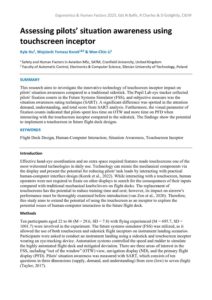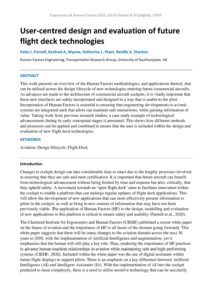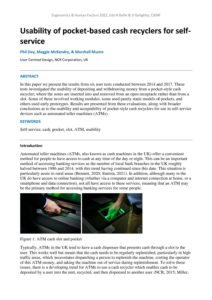Interface design
Design considerations for a Mobility as a Service (MaaS) application – based on analysis of utility
| Document | Author Jisun Kim, Henrietta Howarth, Joy Richardson & John Preston |
| Abstract This study discusses how a MaaS app could be designed and optimised to maximise acceptance by users. Design considerations are suggested based on the analysis of the utility of eleven mobility apps for the general public focusing on the main content and features. |
Software analysis of racing drivers’ interfaces using Link Analysis and Fitts’ Law
| Document | Author James W H Brown, Neville A Stanton & Kirsten M A Revell |
| Abstract This paper discusses the development, application, and proof-of-concept test of software designed to analyse specific aspects relating to the usability of steering wheel-based interfaces in racing cars. A combination of link analysis and Fitts’ Law is employed in order to identify interface efficiency and potential driver physical workload. The racing driver’s primary goal is to win races, this is achieved through a combination of primary and secondary tasks. These sometimes-complex secondary tasks can however overload the driver and cause distraction, leading to driving errors with potentially serious consequences. Equally, drivers experiencing high primary task workload may be more prone to making interface-based errors, particularly when complex secondary tasks are performed. Steering wheel-based interfaces were analysed from four 2017 Formula One season cars, measurements were taken, and control coordinates, dimensions, and control types recorded. A set of typical secondary interactions involving interface controls common to all the cars that might take place within the first ten laps of a race were derived from on-board footage. A software application was developed to load this control layout and interaction data, and carry out link analysis, Fitts’ Law and hybrid calculations. The analysis revealed a range of data, including traversal distances and indices of difficulty for activating individual controls or combinations. This provides insight into efficiency and physical workload levels associated with interface designs. Designs can then by optimised and retested by updating the control layout data, or with variations of interaction data, with the ultimate goal of reducing errors as well as improving safety and driver performance. |
Assessing pilots’ mental workload using touchscreen inceptor for future flight deck design
| Document | Author Joao Paulo Macedo, Kyle Hu, Rani Quiram & Samarth Vilas Burande |
| Abstract Touchscreen displays are one of the pillars of future flight deck design and it is foreseen that at some point traditional flight control inceptors will be modified to a touchscreen version. However, this transition can only be safe and successful with due regard for human performance implications. This study addresses it by comparing pilots’ mental workload for a traditional sidestick and an innovative touchscreen control inceptor. The results indicate that the new technology increases pilot workload, suggesting that further development is required to use it in future flight decks. |
Driver interaction with a semi-autonomous vehicle on the road
| Document | Author Jisun Kim, Kirsten Revell, Pat Langdon, Simon Thompson, Lee Skrypchuk, Jim O-Donoghue, Joy Richardson, Jediah Clark and Neville A. Stanton |
| Abstract The current Society of Automotive Engineers (SAE) Level 2 (automated acceleration and steering capabilities) autonomous vehicles on the market require constant monitoring and intermittent interventions by the driver whenever the system reaches its limitations. Although drivers’ workload could be increased in the processes, interactions associated with them have rarely been explored in a naturalistic environment. Therefore, our understanding about drivers’ interaction with the current generation of autonomous vehicles seems limited. In order to extend the relevant knowledge, this paper investigates drivers’ interaction with a semi-autonomous vehicle in a complex naturalistic urban environment. Five drivers with varying levels of experience in autonomous cars participated in the experiment. Findings show that active monitoring was required in automated driving for safety to gain sufficient situation awareness that preceded manual interventions in certain conditions. The process seemed to be smoother for the experienced drivers as they had a better understanding about capabilities and limitations of the autonomy. Insights to automotive manufacturers on how driver-vehicle interaction could be enhanced are discussed. |
Mapping the contributing factors associated with the Waterloo Underground station accident (2020)
| Document | Author Teodora Stefanova, Gab Parris & Tracey Milne |
| Abstract This paper discusses the use of the AcciMap technique for the analysis of the Waterloo Underground station accident, where a 59 year old man has lost his life following a fall at the Platform-Train Interface (PTI). In addition to mapping the factual sequence of events, the AcciMap allowed us to reflect on latent risk-contributing factors that are worth exploring in view of developing and implementing secondary controls. |
Automated vehicles as a co-pilot: improving communication during the transfer of control
| Document | Author Jediah R Clark, Neville A Stanton & Kirsten M A Revell |
| Abstract Increased automation capabilities create new challenges for automobile designers and manufacturers to address, such as out-of-the-loop performance, mode error, poorly calibrated trust, and breakdowns in communication between agents. A proposed approach to dealing with such issues is to view automation as a co-pilot rather through the implementation of cooperative concepts into automation design. The capabilities for agents to collaborate, coordinate and execute tasks in line with mutual goals and expectations is likely to have a great impact on a number of factors including safety, system efficiency, and trust. The Joint Activity framework proposed by Clark (1996), and applied to automation by Klein et al. (2005), provides a firm theoretical basis in which automation design can be built upon. This draws upon four stages of the handover task in automated vehicles and uses the method of ‘action planning’ to aid in the application of the joint activity framework to handover assistant design. Preliminary themes are discussed, alongside possible practical implications for automated vehicle handover design. |
Attitudes to wireless audio for self-service accessibility
| Document | Author Phil Day, Eleanor Forrest, Cathy Rundle, Lori Di Bon-Conyers and Maggie McKendry |
| Abstract Blind and partially sighted people often use headphones for listening to audio feedback, particularly in public places. This paper presents the results of a survey of blind and partially sighted people regarding their attitude towards using wireless headphones, to avoid the need to plug a physical cable into a machine. Results are presented regarding attitudes to the use of speech input and output in a self-service context. |
Developing an abstraction hierarchy for visual displays in semi-automated vehicles
| Document | Author Jediah R. Clark, Neville A. Stanton and Kirsten M. A. Revell |
| Abstract Understanding how to begin the process of designing a complex system can be challenging. Fortunately, human factors experts have a range of methods available for each step of the process from modelling domain constraints and affordances to more refined concept generation. For domains of high risk such as shared-control automated driving, understanding what, why and how to construct the environment around the human to optimise communication could be a major factor in preventing fatal collisions. In this presentation, we describe the process of developing an abstraction hierarchy – the process of mapping out physical objects, processes and values within the domain of semi-automated vehicles and present a section of this analysis exploring the implementation of visual displays for effective driver-automation communication. |
Developing a Heuristic Tool for Evaluation of Mobility as a Service (MaaS) Mobile Application Interfaces
| Document | Author Joy Richardson, Henrietta Howarth & Jisun Kim |
| Abstract Mobility as a Service (MaaS) mobile phone applications are being launched in many towns and cities worldwide and are heralded as the ultimate modern mobility solution by combining private, public, micro and active travel options. However, in order to encourage adoption by the public the user-experience (UX) is of high importance. A useful way to evaluate the UX of an app interface is to use heuristics analysis, yet none of the existing heuristics tools are tailored towards mobility apps. This means they are not suitable for a systematic evaluation of MaaS interfaces. Therefore a new heuristics tool was developed in order to evaluate the interfaces of mobility apps, including MaaS. This was achieved through the evaluation of existing heuristics combined with the determination of the needs of the mobility app user. A number of iterations were developed, tested and revised in order to design a useful and usable tool. |
Usability of interaction devices whilst wearing personal protective equipment
| Document | Author Victoria Doherty |
| Abstract The impact of wearing personal protective equipment (PPE) on the usability of a set of interaction devices was examined using a single experiment. Participants performed two concurrent tasks: tracking and monitoring/response, while wearing or not wearing PPE, and the resulting performance impact was measured. A differential impact of gloves on device usability according to the glove characteristics was shown. Heavy gloves impaired performance on both response times and the tracking task. Light gloves did not impede task performance. Some headwear was found to hinder colour change detection. Tentative conclusions regarding effects of device orientation and error rates were also made. The results were used to create an update to the extant UK defence standard. Areas proposed for further research include the impact of performance shaping factors on PPE and usability of interaction devices; study of usability impact with different task types; and specific design investigations regarding interaction device design for use with PPE. |
Introducing contactless technology into the financial self-service environment
| Document | Author Elina Jokisuu, Eleanor Forrest, Maggie McKendry, Marshall Munro & Phil Day |
| Abstract The use of contactless technology has grown; this led to a development to integrate it on an automated teller machine (ATM). This case study illustrates the importance of maintaining a holistic view of the entire system (including the physical interface, the onscreen experience, and the person using the technology), particularly when introducing new technology or interaction paradigms. It also demonstrates the benefit of multiple iterative rounds of ideation, concept creation and evaluation; without multiple cycles an acceptable solution would not have been found. Wider lessons are drawn for the design of hardware. |
Flight operations using touchscreen controls: assessing system usability and pilots’ visual attention
| Document | Author Wen-Chin Li, Yung-Hsiang Liang & Wojciech Tomasz Korek |
| Abstract Although the integration of multifunction touch screen controls (TSCs) in future flight decks is under development, some safety concerns still exist from pilots’ point of view. It is important that usability and human factors considerations are therefore studied in realistic operational environments. This short paper investigates the usability and human-computer interaction associated with TSCs, using eye tracking technology for future flight deck design. |
Design with intent on the flight deck
| Document | Author Victoria A. Banks, Katie J. Parnell, Katherine L. Plant & Neville A. Stanton |
| Abstract New flight deck technologies must be carefully integrated to ensure that the demands of the system match the capabilities of the user. However, as technological advances make technologies more efficient, end users become the increasingly weak link within the chain. With this in mind, it is important that manufacturers take the time to acknowledge Human Factors within the design process and utilise opportunities to engage with actual end users, in this case line pilots. This article focuses on the design and development of a new pilot decision aid that can offer flight crews with relevant information regarding the status of the aircraft during abnormal operating procedures (e.g. following an indication of an engine oil leak). It utilises the Design with Intent method to generate novel design concepts for a new flight deck interface. This is a new method to apply to the domain but holds the potential to incorporate extensive feedback from pilots into the design of new technologies in the flight deck. Preliminary findings from workshops with pilots using this method are discussed with examples taken from the workshop on how the method can inform design concepts. Overall the method was found to generate important key areas of discussion that can be utilised in a user-centred design approach within future flight deck technology development. |
Proximity Warning System Interfaces for Mining Vehicles: Can the Minerals Industry Learn from the Automotive Domain?
| Document | Author Tim HORBERRY, Kristie YOUNG and Robin BURGESS-LIMERICK |
| Abstract In the global mining industry, proximity warning systems are being increasingly deployed in mobile equipment such as haul trucks, partly due to the risk of collisions. This research first reviewed best practice interface design for new technologies in the automotive domain: for example, the European Statement of Principles on Human Machine Interfaces. Thereafter it reviewed the different types of proximity warning interfaces available in mining. Analysis then compared the identified best practice in automotive with current proximity warning interfaces in mining. Gaps found are discussed, and recommendations to improve the interface design of proximity systems in mining are proposed. |
Inception, ideation and implementation: developing interfaces to improve drivers’ fuel efficiency
| Document | Author Craig K. Allison, Neville A. Stanton, James M. Fleming, Xingda Yan, Forough Goudarzi & Roberto Lot |
| Abstract Cognitive Work Analysis has become a staple methodology for human factors and ergonomics researchers and practitioners. Despite this popularity, limited guidance is available to take the insights of the methodology forward into the development of newer systems and interfaces. This paper describes the use of the established design toolkit ‘Design with Intent’ as a suitable approach to help progress the insights of Cognitive Work Analysis towards the development of novel interfaces. An abridged account of developing a Cognitive Work Analysis for fuel efficient driving is presented, alongside the application of the Design with Intent toolkit to progress the insights from the Cognitive Work Analysis to generate novel design ideas which can be incorporated into future interfaces. Finally, early development work, compiling the ideas generated using the Design with Intent toolkit, is presented, demonstrating the potential for this combination of methods to produce interfaces for future testing and validation. |
Interface usability evaluation of mobility apps aimed at inclusive design
| Document | Author Henrietta Howarth, Joy Richardson, Jisun Kim & John Preston |
| Abstract This study evaluated the interface usability of a range of mobility apps using a set of adapted heuristics aimed at inclusive design. Identified strengths and weaknesses informed interface design recommendations for a future MaaS app to enhance usability and support travel across all ages and genders of adults in the Southampton area. |
Cultural Aspects for the User Interface Design of Health and Fitness Apps
| Document | Author Fiona Zheng and Setia Hermawati |
| Abstract Cultures influence preferences towards user interface (UI) which prompted the emergence of the culture-based UI design approach. Hofstede’s cross-cultural theory identified Hong Kong as having a unique culture orientation in comparison to western countries or mainland China. This study aimed to investigate Hong Kongese preference on the UI of health and fitness apps. Three human factors experts systematically analysed two comparable apps designed by mainland Chinese and Western companies. The results were then used to guide an online survey (n=103) exploring the preferences of Hong Kongese. The systematic analysis showed that UI differences observed between the two apps corresponded well with cultural dimension differences between the United States and Mainland China; suggesting an unmet need for culturally sensitive UI. The online survey showed that UI preferences are also significantly affected by age and gender (p < 0.05); suggesting the culture-based UI design approach alone was insufficient to guide UI design. |
Exploring the Perceived Privacy of On-Screen Information and Its Impact on the User Interface Design of a Self-Service Terminal
| Document | Author Elina JOKISUU, Andrew W. D. SMITH and Phil DAY |
| Abstract Self-service terminals (SSTs) such as automated teller machines (ATMs), often handle information that is personal and sensitive in nature e.g. financial details. So it is vital that the user feels their information privacy is not compromised by the SST. This exploratory study investigates how users perceive the privacy of an ATM user interface. Using paper prototyping and role-play, the study participants identified those user interface areas they perceived to be the most and least private. |
Assessing pilots’ situation awareness using touchscreen inceptor
| Document | Author Kyle Hu, Wojciech Tomasz Korek & Wen-Chin Li |
| Abstract This research aims to investigate the innovative technology of touchscreen inceptor impact on pilots' situation awareness compared to a traditional sidestick. The Pupil Lab eye tracker collected pilots' fixation counts in the Future Systems Simulator (FSS), and subjective measure was the situation awareness rating technique (SART). A significant difference was spotted in the attention demand, understanding, and total score from SART analysis. Furthermore, the visual parameter of fixation counts indicated that pilots spent less time on OTW and more time on PFD when interacting with the touchscreen inceptor compared to the sidestick. The findings show the potential to implement a touchscreen in future flight deck designs. |
User-centred design and evaluation of future flight deck technologies
| Document | Author Katie J. Parnell, Rachael A. Wynne, Katherine L. Plant, Neville A. Stanton |
| Abstract This work presents an overview of the Human Factors methodologies, and applications thereof, that can be utilised across the design lifecycle of new technologies entering future commercial aircrafts. As advances are made to the architecture of commercial aircraft cockpits, it is vitally important that these new interfaces are safely incorporated and designed in a way that is usable to the pilot. Incorporation of Human Factors is essential to ensuring that engineering developments to avionic systems are integrated such that pilots can maintain safe interactions, while gaining information of value. Taking work from previous research studies, a case study example of technological advancements during its early conceptual stages is presented. This shows how different methods and processes can be applied and combined to ensure that the user is included within the design and evaluation of new flight deck technologies. |
Usability of pocket-based cash recyclers for self-service
| Document | Author Phil Day, Maggie McKendry & Marshall Munro |
| Abstract In this paper we present the results from six user tests conducted between 2014 and 2017. These tests investigated the usability of depositing and withdrawing money from a pocket-style cash recycler; where the notes are inserted into and removed from an open receptacle rather than from a slot. Some of these involved working modules, some used purely static models of pockets, and others used early prototypes. Results are presented from these evaluations, along with broader conclusions as to the usability and acceptability of pocket-style cash recyclers for use in self-service devices such as automated teller machines (ATMs). |
How does explainability affect perceived transparency, trust, acceptance and usefulness?
| Document | Author Yifan Ding, Setia Hermawati |
| Abstract The effects of explainability on perceived trust, transparency, acceptance and usefulness were explored in a within subjects’ study (n=15) using an online shopping recommender system as a context. The study investigated three levels of explainability (low, medium, high) and perceived transparency, trust, acceptance and usefulness were obtained using standardised questionnaires. |

